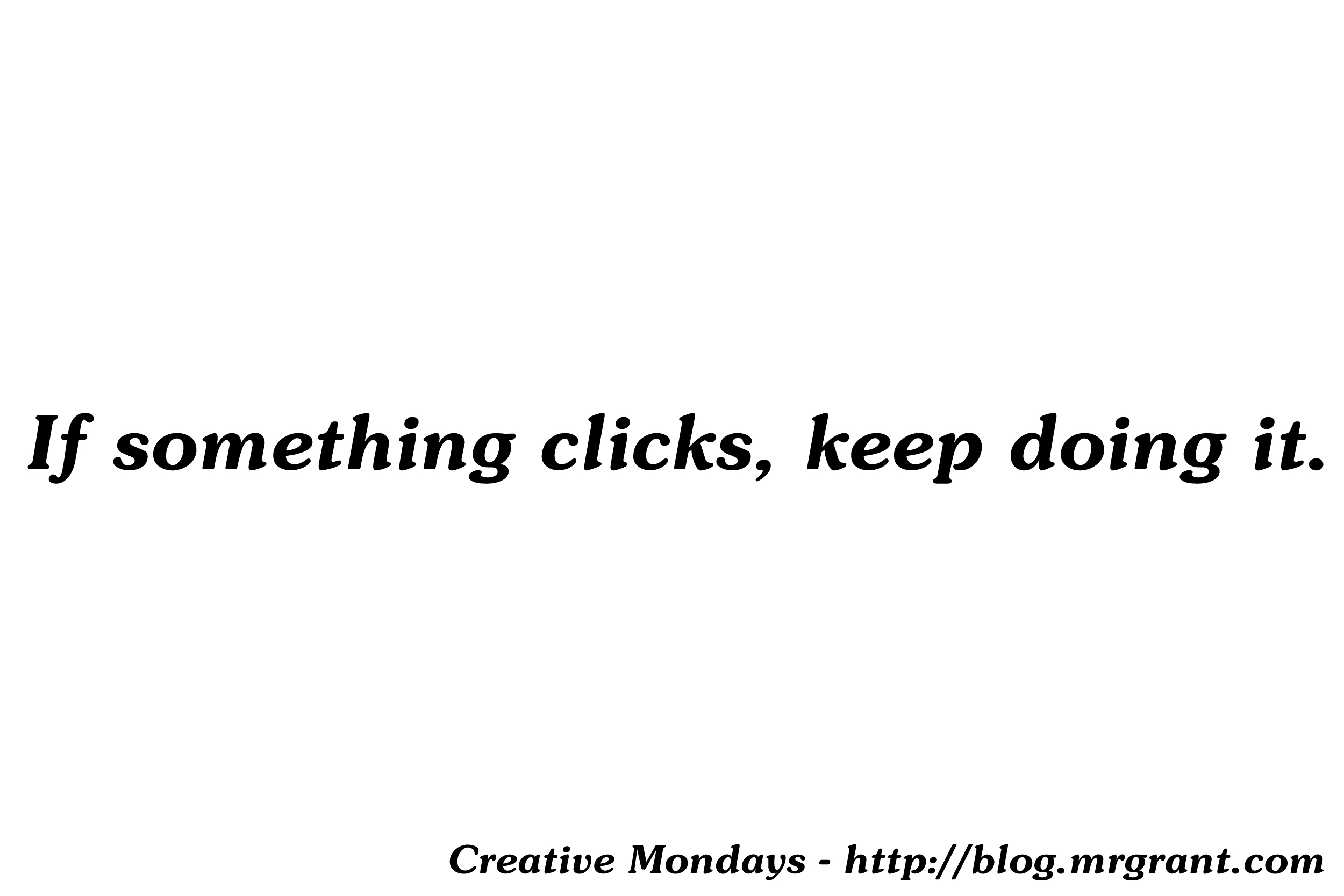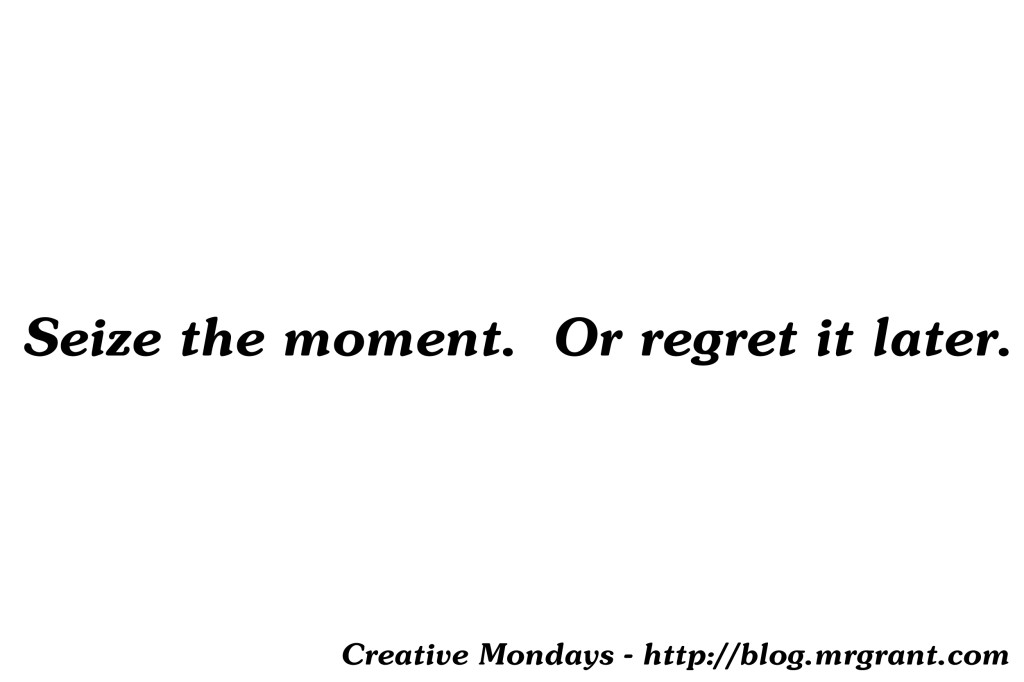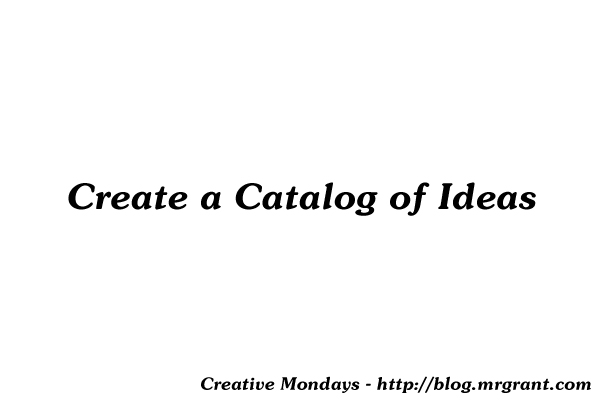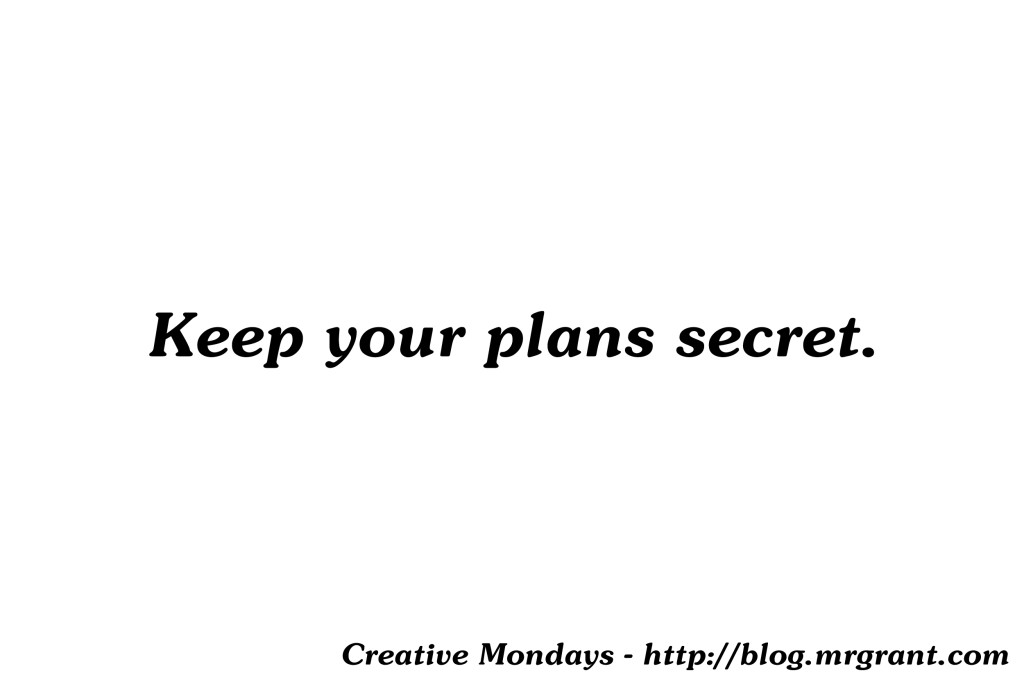Tag: create
Creative Mondays #011 – If something clicks, keep doing it.

When I began training to be in The Jim Henson Company’s Puppet Up, part of the training was improv classes. After taking those classes for a while, I started taking classes outside of Henson, through The Imrpovatorium. Most of my classes were with Patrick Bristow but I had a few other teachers as well. One class I took was a long form improv class with Ted Michaels. Ted is a brilliant improviser and he is also a member of Puppet Up. Ted is a great teacher and knows a lot of great structures to help drive home the core concepts of improv.
I don’t remember the exact name, but one of the structures we did really hit me as being funny and, as I was thinking back about it today, the principles of it can be applied to creativity. The improv scenes started out just like most other improv scenes. Two people got a suggestion and then began the scene. The rule of this game was to go through the scene as normal until the first big, whole audience, laugh. Then, whatever it was that got that laugh, the two improvisers just keep doing that. The point being that if you keep following that first big laugh, most of the time the scene will continue to be really, really funny. I’ll give you an example.
My friend Chris and another improviser were doing a scene that involved them getting into a car. Once inside the car, Chris made a move to roll down the car’s window. Of course, he was ‘space-working’ or miming it because there wasn’t a car on stage. So Chris made the move to roll down the window but his move was just really weird and not how you would go to roll down a real car window. It was funny because the audience immediately thought, “What kind of crazy wind controls does this car have?” That move got a big laugh.
So Ted said, “Okay, the scene is now about this ‘awkward space-work’ car.”
So Chris and his partner just went on with the dialogue as normal, but everything in the car, turning on the radio, opening the sunroof, pushing in the cigarette lighter, became these really big awkward physical movements. The scene was so funny. As the class continued, time and time again it was proven that if you just kept following that one thing that tickled the audience, the scene will succeed. Of course there were exceptions to the rule, but for for the most part, it worked.
Now, another improv teacher I’ve had would agree to an extent. I believe he would say you should pursue what the audience feels is funny, yes, but be aware when they are ready to move on to something new. Then look for the next thing and follow that.
I think this theory or pursuing what ‘clicks’ with the audience can be applied to creative work as well.
If you find that you create a piece of art that really clicks with your audience, follow it. Keep creating in that manner. Now I’m not saying paint the same painting over and over again, but if you find a style that hits with your audience, keep creating in that style. If you’re a writer and a story or book hits, write another with the same characters or in the same universe. If a sculpture you create is a hit, create in the same style for the next one. Follow what clicks with your audience. I’m also not saying never create in another way again, that would be boring. But if you find something that works, go with it until it doesn’t work anymore and then try something else.
I can point to an example of this in The Radio Adventures of Dr. Floyd. In 6 seasons of the show we followed the same ‘time travel’ formula. Dr. Steve wanted to steal historical artifacts and Dr. Floyd tried to stop them. After six seasons I wanted to try something else. Shake up that formula a little. So I created a season long storyline where Dr. Floyd and Dr. Steve got trapped inside classic literature. Now, I think these were some of our most fun shows and showed that the Dr. Floyd characters could still exist in another format. Some in the audience didn’t think so. While many folks loved Season 7, we got plenty of feedback from folks who missed the time travel formula we had done over the previous seasons. So, you’d better believe we brought it back for what was the eight and final season.
Dr. Floyd really clicked with people and I followed it until it was impossible to do so anymore due to issues that arose between myself and the other co-creator of the characters. Since then, I’ve created other similar style projects and some of that audience stayed with me. True, many want Dr. Floyd to return, but that’s just not possible now. But those who like the way I produced audio drama have followed and, I hope, they aren’t disappointed as I’m still creating in the same style. I’ve set up Saturday Morning Theatre as sort of a testing ground where I can produce different types of shows and if one of those shows really clicks, I can run with it and produce more. The Tales Deputy Guppy seems to have a pretty good fan base, so there will definitely be more episodes of that. The Adventures of The Thunder Crester got sort of a lukewarm response, so I may make a few more episodes to wrap up the storyline, but I probably won’t be producing more seasons of it.
If something clicks with your audience, keep doing it.
—
Have you ever had something click with your audience? If so, what did you do? Did you follow it or try something different? Let me know in the comments below.
Creative Mondays #009 – Seize the moment. Or regret it later.

When I first thought about the topic for today’s post, I figured this would only work for those who are in the performing side of the creative arts world. But the more I thought about it, the more I feel it applies to everyone in the art world and, heck, everyone in general. Again, it’s a saying we have all heard a million times, but it bears repeating:
Seize the moment. Or regret it later.
This has rumbled back around in my brain this past week because I failed to seize a moment presented to me this past week and I’m totally regretting it now. Let my tale be a lesson to you all.
As you may or may not know, I am a ringside interviewer for Championship Wrestling from Hollywood. It is a totally fun job with a great group of people and last Sunday (February 23) I worked the latest round of TV Tapings for the show.
Before the show I found out that we would only have one permanent commentator for the day, the fantastic Johnny LaQuasto. He would be joined periodically on commentary by manager Stu Stone, but for the most part, he would be on his own. During the tapings, I sit next to the commentators table to ring the bell for the start and finish of each match and to be able to hop down to ringside to conduct the interviews. So I’m very close to the ‘action.’
Before we started the show, Stu Stone took me aside and said, “Listen, I have to be ringside for a lot of the matches and LaQuasto will be on his own. Hop on to commentary when I’m not there.” I nodded and said, “Okay.”
Now, I have never done commentary before. I had thought about it, yes, but never have I stepped up to the mic to actually call a match. My brain started tumbling with thoughts, “Yeah, you should totally do it. But what if I suck? Well, then they’ll never have you do it again, but you aren’t going to kill anyone by doing it. But I know I will suck.” The old negative brain hard at work.
The show started and Johnny and Stu were on commentary and soon Stu was off to head to ringside. I put on the extra headset (earphones and a mic) and sat there and…I didn’t say anything. Not that I was prompted to, Johnny was doing just fine solo. But in my head I felt, “I don’t really have the okay from someone in charge to do this so I’m not going to say anything. Plus, I’ve never done it so I’ll probably be bad at it.”
At one point during a match, Stu came past the table while running around the ring and yelled at me, “Why aren’t you saying anything?!” I laughed, but deep down I knew he was right. I should just start talking. Stu Stone is one of the best managers working the ‘indy’ wrestling world today. He got to that position by seizing EVERY opportunity that came his way.
So I sat there, pretty much the whole taping, with the headset on and I didn’t say a word. Because my brain was telling me that I’d be bad at it and I had this fear that I would ‘get in trouble.’
Days after I’m still regretting that decision for several reasons. First of all, I wouldn’t have been ‘bad’ at doing commentary during the match. I wouldn’t have been the next coming of Jim Ross by a long shot, but I wouldn’t have been as ‘bad’ as my brain had me convinced. I’m a strong improviser, I’ve been watching wrestling since 4th grade and I know all the guys in the ring. I could have done it. And, besides, if my commentary had been REALLY bad, I would have realized and I could have just dropped out at the end of the current match and not done it again. No biggie.
Secondly, I wouldn’t have ‘gotten in trouble.’ I wouldn’t have been fired or drummed out of wrestling. The worst case scenario is that Dave Marquez, our director and executive producer, would have just told me not to do it again. But again, knowing Dave, that would have only been if I would have been miserably bad, which we already have stated I wouldn’t have been. Had I seized the chance and it had been halfway decent, it would have shown to Dave and the other producers of the show that there is another place I can be plugged in during the shows.
I should have seized the opportunity. Now I just regret it.
Don’t let this happen to you. If you get the opportunity, seize it. Or regret it later.
—
Okay, let’s hear about the opportunities you failed to grab hold of. Why didn’t you jump? What did you learn from not seizing the chance to do something?
Creative Mondays #008 – Create a Catalog of Ideas.

Here is the third installment of creative ideas I took away from seeing Joel Hodgson’s talk “Riffing Myself” in Northern California recently. I highly recommend going to see this show, even if you aren’t a fan of Mystery Science Theatre 3000. It’s a great show for anyone who is creative and, to me, gives great insight on how things, great things like Mystery Science Theatre 3000, are created. You can read the previous two blogs here: Don’t do what you don’t want to do & Nothing ever comes out done.
This final topic is actually a topic that I already have written on and was scheduled to come up soon here on the blog. I may touch upon it again in upcoming weeks, but I really waned to use Joel’s talk as a springboard to write on this idea. The idea of a creative idea book.
Joel told the story of taking a sculpture class in college where the instructor made all the students buy a big, black, hardbound sketch journal to use in the class. Joel thought the idea was a bit pretentious in that he felt he didn’t have any ideas worth putting into a hardbound journal, but it was a requirement so he picked one up. In his talk, Joel actually shows scans of the first two pages of the journal they are filled with ideas for different sculptures. Then he shows a scan of the third page where there are sculpture ideas on the top of the page and below is an, almost comical, mock up of a trick Joel wanted to create for his magic act. He then goes on to show other pages and, never again, were any of the pages adorned with sculpture ideas. From that page on it was ideas for things Joel wanted to create.
Joel calls this his Catalog of Ideas. He likens it to the old magician’s catalog he loved thumbing through as a kid. Full of wondrous things. Possibilities. Things that may happen of may not. His Catalog of Ideas was a storehouse of thoughts on things to create. Some he acted on immediately. Others lay dormant on the page, perhaps to be acted on in the future. He also spoke how, a lot of times, several different ideas in the Catalog would be combined together to create something completely different from anything else. He wrapped this part of the speech up by showing a picture of a closet, I’m assuming, in his office that is now full of large, black, hardbound sketch journals. His catalog of ideas. (Side Note: If you’re as big a fan of Joel’s as I am, wouldn’t you just love to thumb through those?)
So, a Catalog of Ideas. I have to admit, I don’t really keep one like the one Joel mentions in his talk. I think Joel is a lot more visual than I am where I prefer to write things out. Most times if I have an idea I will type it into the notes on my phone. Or I’ll just let it rattle around in my head until it’s so big I just have to act on it. I have recently been keeping a sort of idea journal. It has some ideas but it also has notes from meetings and classes, so it’s not strictly an idea journal. But you know what? I’m going to take it as a challenge to start a Catalog of Ideas of my own. I’ll let you know how it goes.
Again, I will plug Joel’s show. Go see it. For info visit his website here – www.JoelHodgson.com
—
Do you keep your own Catalog of Ideas? If so, how long have you done it? Tell us about it in the comments below. If you don’t keep one, how do you store all your creative ideas? Again, let me know below.
Creative Mondays #005 – Keep you plans secret.

Keep your creative plans secret until they are completed.
This is a tough one and, though I believe in it and will explain why, it is a hard one for me to do.
The main reason you should attempt to keep your creative plans secret until you have completed them is because if you tell them to other people they will, no matter how well meaning they are, offer their opinion on your plans. You will get no end to unsolicited feedback on your idea.
“That’s a great idea!” they’ll inevitably start, but then they’ll continue, “You know what you should do…”
Now if the sentence above is coming from someone you admire or respect or whom you are asking for advice, that’s fine. If you admire or respect them or asked for their advice, that’s great, listen to their suggestions. Remember, though, these are suggestions.
The focus of this entry is about telling friends, peers, family about your plans. These folks like (love) and respect you and they think they’ll be helping you out by offering their advice. What happens then is that once you begin creating your art, the ‘advice’ that these people starts creeping into your head and you begin second guessing yourself.
“Maybe so and so was right. Maybe I should do it their way instead of the way I had planned.”
This becomes dangerous because suddenly the your art is not your own. It has become a community project. Nothing against community projects, they are great, but this is YOUR art project.
This is the number one reason I try to keep my ideas to myself. Notice I say try. It’s extremely hard to do. The main reason for blabbing is I get really excited about an idea and I want to share it with the world. I need to realize that it’ll be much better (and save me much second guessing) if I tell people after it’s done. Or better yet, show them. Writers often say ‘show don’t tell.’ I think that’s a great bit of advice that all artists can take about their own work. Get it done and THEN show somebody.
Another reason to keep mum about a project is because sometimes I talk so much about a project I never really get around to actually working on it. I know it sounds weird, but there’s something in the brain that will trick you into thinking, “Well I’ve talked about it so much, I must have done it.” When, in actuality, you haven’t done anything. Almost as if a little bit of the creative desire in you escapes each time you say something about it until you have no creative desire left to work on the project.
Finally, there is the thought of sharing your ideas with others before you do them and then someone steals your idea. I don’t think this happens as much as people are afraid it does, but it does happen, so it’s another good reason to just keep quiet about your project.
As artists, our main drive in life is to create something and then share it with the world. We should just think twice about sharing them before we’ve even begun creating them.
—
Do you fall into the same pitfalls as me and blab your project to everyone around you? Or do you thrive on getting other people’s opinions about your project? Let me know in the comments below.